Touring Europe 2012
England, France, Monaco, Italy, Croatia, Hungary, Slovakia, Poland, Germany, Holland, Belgium
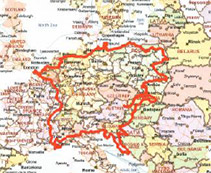
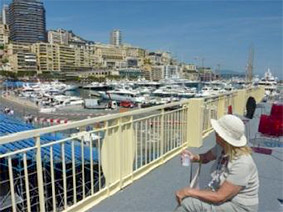 Off again to Europe at the beginning of May, via a very interesting short stop in Seoul, South Korea, a vibrant and prosperous place indeed. Having picked up the van from its winter rest in Dorset, we set off for Calais and the ferry and pressed on south through France quite quickly to get to the camp site at Menton, just east of Monaco. Menton was our base for attending the marvellous Grand Prix Historique de Monaco, a series of races for grand prix cars dating back to pre-war times. This is one of the internationally great historic car race meetings, and we enjoyed marvellous viewing and hospitality arrangements.
Off again to Europe at the beginning of May, via a very interesting short stop in Seoul, South Korea, a vibrant and prosperous place indeed. Having picked up the van from its winter rest in Dorset, we set off for Calais and the ferry and pressed on south through France quite quickly to get to the camp site at Menton, just east of Monaco. Menton was our base for attending the marvellous Grand Prix Historique de Monaco, a series of races for grand prix cars dating back to pre-war times. This is one of the internationally great historic car race meetings, and we enjoyed marvellous viewing and hospitality arrangements.
From Menton we drove a short distance west and inland to stay a few days in Provence with very long-time sailing friends, who took us round several of the lovely villages of Provence and along the coast.
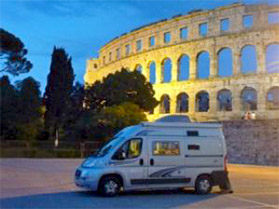 We decided to cross northern Italy as quickly as possible, and did it in a day – a day of one of the worst driving conditions imaginable, with driving rain and appalling visibility among the many trucks on the autostrada. We then looped round the top of the Adriatic and down into the peninsula of Istria, Croatia. A highlight was Pula, a big port city where we spent the night “camped” (that is, in a car park) right under one of the most amazingly maintained Roman amphitheatres in the world. We visited Pula in our yacht Cera in 1987, and could still remember that first time we wandered round the arena. Incredibly, this was our fifth visit to Croatia and the former Yugoslavia since our first in 1961.
We decided to cross northern Italy as quickly as possible, and did it in a day – a day of one of the worst driving conditions imaginable, with driving rain and appalling visibility among the many trucks on the autostrada. We then looped round the top of the Adriatic and down into the peninsula of Istria, Croatia. A highlight was Pula, a big port city where we spent the night “camped” (that is, in a car park) right under one of the most amazingly maintained Roman amphitheatres in the world. We visited Pula in our yacht Cera in 1987, and could still remember that first time we wandered round the arena. Incredibly, this was our fifth visit to Croatia and the former Yugoslavia since our first in 1961.
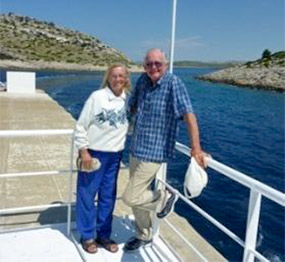 After our loop round Istria, we drove down the coast via the major cities of Split, Zadar, and on to Dubrovnik. From Zadar we took a boat trip out to and around the Kornati islands, giving us another view of waters we had sailed over in years gone by. The whole coast road down to Dubrovnik presents beautiful views of the sea and islands and multiple little coves and harbours, surrounded by the terracotta red tiled roofs of the local dwellings.
After our loop round Istria, we drove down the coast via the major cities of Split, Zadar, and on to Dubrovnik. From Zadar we took a boat trip out to and around the Kornati islands, giving us another view of waters we had sailed over in years gone by. The whole coast road down to Dubrovnik presents beautiful views of the sea and islands and multiple little coves and harbours, surrounded by the terracotta red tiled roofs of the local dwellings. 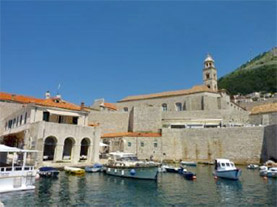 Our access to Dubrovnik was by means of a boat trip from a little wharf in the village of Mlini, reached by over 100 steps down from the camp site. It was a lovely run in to the main little harbour right at the “front” east wall of Dubrovnik, a wonderful approach to this gorgeous city. Our first task, of course, was to walk the walls before the hordes of tourists had the same idea. From the walls we could still see some damage from the Serbian shelling of the ‘90s, but it was no longer very obvious. All the old roofs are now being replaced by new terracotta tiles to create a harmonious whole, but still don’t quite match the brownish tinge of the roof of pre-war days.
Our access to Dubrovnik was by means of a boat trip from a little wharf in the village of Mlini, reached by over 100 steps down from the camp site. It was a lovely run in to the main little harbour right at the “front” east wall of Dubrovnik, a wonderful approach to this gorgeous city. Our first task, of course, was to walk the walls before the hordes of tourists had the same idea. From the walls we could still see some damage from the Serbian shelling of the ‘90s, but it was no longer very obvious. All the old roofs are now being replaced by new terracotta tiles to create a harmonious whole, but still don’t quite match the brownish tinge of the roof of pre-war days.
Even in this relatively prosperous part of the country we could see obvious signs of the Yugoslavian civil wars of the ‘90s, with abandoned and apparently war-damaged buildings, including large hotels and resorts. Many dwellings and developments were evacuated by Serbs, by choice or chance, and they cannot now reclaim their property for bureaucratic reasons supported by ethnic loyalties. We drove back up Croatia on an inland route, all new to us. This opened our eyes to the further devastation brought about by the dreadful ‘90s wars. Few visitors venture inland, and thus don’t see the several villages left bombed out and deserted, and the cities with rotting infrastructure interspersed with Communist-era blocks of flats. But most of rural Croatia is lovely, and we had a wonderful visit to the Plitvicka Jezera national park and its famous series of lakes. A rustic boardwalk wound down around each of the four big lakes and the beautiful travertine (steps built by organic growth) waterfalls linking them. We walked through many connecting travertine areas with small streams and little waterfalls all around us, stunning. With Dubrovnik, this was a highlight of our Croatian tour.
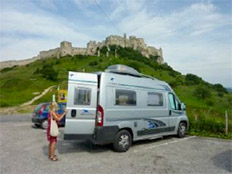
 We skipped Zagreb, and went quite quickly through Hungary to Slovakia, a mountainous country that was completely new to us. Obviously, it used to be united with the Czech Republic as Czechoslovakia, but that was always artificial, because they are quite different places culturally and linguistically. The Czech Republic is much more western in style, like Germany really, whereas Slovakia leans to the east in its Slav manners and language. The first major stop was at the town of Banska Bystrica, where we visited the Museum of the Slovak National Uprising (SNP). The museum focuses on the history of Slovakia during the 1938-45 period, with emphasis on the 1944 uprising against the Nazis. Slovakia, under the fascist priest Josef Tiso, had strongly supported the Nazis and assisted in the deportation and murder of tens of thousands of “unwanted”, mainly Jews of course. We also visited the site of a concentration/death camp nearby. The uprising was a brave local reaction to all that. Before travelling in these eastern European countries we hadn’t realised the depth of anti-Semitism that existed in those years and before, quite irrespective of the Nazi terror.
We skipped Zagreb, and went quite quickly through Hungary to Slovakia, a mountainous country that was completely new to us. Obviously, it used to be united with the Czech Republic as Czechoslovakia, but that was always artificial, because they are quite different places culturally and linguistically. The Czech Republic is much more western in style, like Germany really, whereas Slovakia leans to the east in its Slav manners and language. The first major stop was at the town of Banska Bystrica, where we visited the Museum of the Slovak National Uprising (SNP). The museum focuses on the history of Slovakia during the 1938-45 period, with emphasis on the 1944 uprising against the Nazis. Slovakia, under the fascist priest Josef Tiso, had strongly supported the Nazis and assisted in the deportation and murder of tens of thousands of “unwanted”, mainly Jews of course. We also visited the site of a concentration/death camp nearby. The uprising was a brave local reaction to all that. Before travelling in these eastern European countries we hadn’t realised the depth of anti-Semitism that existed in those years and before, quite irrespective of the Nazi terror.
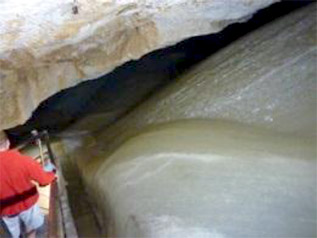 We went on to tour lots of very pretty farmland and made a fascinating visit to some famous “ice caves”, which like everywhere else in this hilly place involved some tough walking! The ice in the caves is essentially an underground glacier that once upon a time filled up the entire system, an amazing and rare sight indeed. Off then to the Spis region, where a federation of 24 Spis towns was founded by industrious Germans given trading privileges by the Hungarian Crown after the devastating Mongol invasion of the 13th century. We then worked our way up north with more visits to ruined and restored castles, of course, all built – naturally – on tops of rocky crags that need struggling up! There are some beautiful traditional villages, too, with mostly wooden houses, some decorated with painted patterns and other left in bare, bright wood that is kept meticulously clean by the women who make a concerted effort at it each spring. These houses are very old, but most still look like new.
We went on to tour lots of very pretty farmland and made a fascinating visit to some famous “ice caves”, which like everywhere else in this hilly place involved some tough walking! The ice in the caves is essentially an underground glacier that once upon a time filled up the entire system, an amazing and rare sight indeed. Off then to the Spis region, where a federation of 24 Spis towns was founded by industrious Germans given trading privileges by the Hungarian Crown after the devastating Mongol invasion of the 13th century. We then worked our way up north with more visits to ruined and restored castles, of course, all built – naturally – on tops of rocky crags that need struggling up! There are some beautiful traditional villages, too, with mostly wooden houses, some decorated with painted patterns and other left in bare, bright wood that is kept meticulously clean by the women who make a concerted effort at it each spring. These houses are very old, but most still look like new.
And so to Poland, a major destination for this year, and we were in the country for five weeks. It was one of the most fascinating nations we have ever visited. One of the main reasons for this is its extraordinarily complicated and turbulent history, which over the centuries has disrupted both its infrastructure and its populations. Sitting in the very middle of continental Europe, between the major powers of Germany, Austria and Russia, it has been in conflict with its neighbours for a thousand years and under existential threat for hundreds. But in the early 14th century Poland became a mighty state, and the then royal capital, Krakow, was a flourishing city. In alliance with Lithuania it became a vast nation that lasted four hundred years. The Teutonic Knights had subordinated Prussia, but in a famous battle they were beaten by the Polish alliance, which thus gained access to the Baltic coast and the sea. Culturally the nation continued to bloom. In science, Nicolaus Copernicus radically reset the religious and scientific world view by proving that the earth moved round the sun.
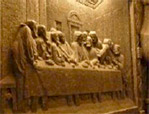 Politically, however, the country became a mess during the 16th and 17th centuries. All power was with the nobility, which not only owned nearly all the land (and, effectively, the peasantry) but also controlled the parliament through the power of a single-vote veto which made any liberal changes impossible. They even selected foreign kings, whom the nobles could manage. Foreign invaders continued to cut slices off the country, and the Swedish invasion of 1655 – the “Deluge” – was particularly disastrous. By 1795 Prussia, Russia and Austria had divided up the country between them, and it ceased to exist as a nation for over 120 years, until European borders were redrawn following WW1. During our travels we saw and read much evidence of this history, and the even more terrible story of WW2. But the dogged, resilient Polish people seem to be well re-established now, as a respected EU nation with an assured future.
Politically, however, the country became a mess during the 16th and 17th centuries. All power was with the nobility, which not only owned nearly all the land (and, effectively, the peasantry) but also controlled the parliament through the power of a single-vote veto which made any liberal changes impossible. They even selected foreign kings, whom the nobles could manage. Foreign invaders continued to cut slices off the country, and the Swedish invasion of 1655 – the “Deluge” – was particularly disastrous. By 1795 Prussia, Russia and Austria had divided up the country between them, and it ceased to exist as a nation for over 120 years, until European borders were redrawn following WW1. During our travels we saw and read much evidence of this history, and the even more terrible story of WW2. But the dogged, resilient Polish people seem to be well re-established now, as a respected EU nation with an assured future.
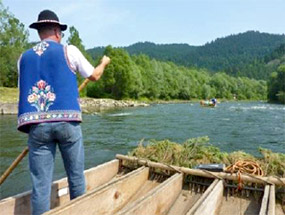 Our first major excursion in Poland was to take a ride in a punt, shared by two German couples in our camp site in Zakopane, through a gorge in the Demajec river in the far south of the country. Two crewmen in traditional dress control these punts through shallow rapids and slow-moving pools, with steep cliffs and forests on either side. We enjoyed several other spectacular and memorable outings. From Krakow we took a trip out to the Wieliczka Salt Mines, starting with a long staircase down to the mine tunnels. These lead past caverns big and small, several with figures carved by miners in the salt over the ages. The rock salt is mostly grey, with veins of white pure NaCl running through it.
Our first major excursion in Poland was to take a ride in a punt, shared by two German couples in our camp site in Zakopane, through a gorge in the Demajec river in the far south of the country. Two crewmen in traditional dress control these punts through shallow rapids and slow-moving pools, with steep cliffs and forests on either side. We enjoyed several other spectacular and memorable outings. From Krakow we took a trip out to the Wieliczka Salt Mines, starting with a long staircase down to the mine tunnels. These lead past caverns big and small, several with figures carved by miners in the salt over the ages. The rock salt is mostly grey, with veins of white pure NaCl running through it. 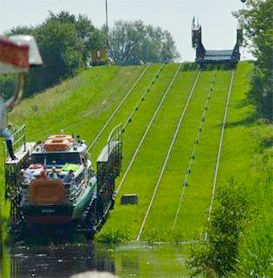 The biggest cavern has been converted into a church of substantial size, lying at 135 metres below the surface. Some of the skilled miners’ carvings and reliefs are superb. Later, we visited the amazing boat lifts on the Elblag Canal, which links Elblag and Ostroda in the north. Construction began in 1844, but the height difference between the penultimate lake and the seaward one, Lake Druzno at Elblag, is 99.5 metres. This difference was too great to be managed by conventional locks. The ingenious solution was to build a series of lifts. Boats float on to cradles, which are then hauled out by an endless loop of cable and travel up and down a series of grassy slopes on rails. We rode a tourist ship from the bottom to the top, in and out of the water, enjoying the sight of other vessels, big and small, going down past us on parallel rails.
The biggest cavern has been converted into a church of substantial size, lying at 135 metres below the surface. Some of the skilled miners’ carvings and reliefs are superb. Later, we visited the amazing boat lifts on the Elblag Canal, which links Elblag and Ostroda in the north. Construction began in 1844, but the height difference between the penultimate lake and the seaward one, Lake Druzno at Elblag, is 99.5 metres. This difference was too great to be managed by conventional locks. The ingenious solution was to build a series of lifts. Boats float on to cradles, which are then hauled out by an endless loop of cable and travel up and down a series of grassy slopes on rails. We rode a tourist ship from the bottom to the top, in and out of the water, enjoying the sight of other vessels, big and small, going down past us on parallel rails.
We enjoyed getting into Polish food, too, because the cost of living for us – including eating “out”, which we normally don’t do a lot – was incredibly cheap for us on the Oz dollar. Poland, although in the EU, is not in the Eurozone – if they joined now, they’d all go broke immediately. Among other local specialties we relished potato pancakes, buckwheat blood sausages with apple and marjoram, stuffed dumplings, pig knuckles cooked in beer, and sour rye soup in a bowl formed by the crust of a spherical loaf.

 Krakow is famous as one of the most wonderful cities in Europe, with highlights being the magnificent castle and cathedral. A special treat was a close and relaxed viewing of Leonardo da Vinci’s small painting, Lady with an Ermine, set by itself in a small room. The painting had recently returned from the massively popular Leonardo exhibition in London. It was wonderful to see such a world-famous, brilliant work so close and under such peaceful and uncrowded conditions. It matches La Gioconda in its perfection.
Krakow is famous as one of the most wonderful cities in Europe, with highlights being the magnificent castle and cathedral. A special treat was a close and relaxed viewing of Leonardo da Vinci’s small painting, Lady with an Ermine, set by itself in a small room. The painting had recently returned from the massively popular Leonardo exhibition in London. It was wonderful to see such a world-famous, brilliant work so close and under such peaceful and uncrowded conditions. It matches La Gioconda in its perfection.
Warsaw has something of a war-torn image, inevitably, but it is one of the several cities and towns which – at least in the centre – have been amazingly restored to the shape of their glorious past, often using contemporary paintings and drawings as a guide. The purist might decry these rebirths as mere replicas, but the alternative – more massive Russki blocks, of which there are plenty in the suburbs – is unthinkable. The Baroque Royal Castle, Zamek Krolewski, is now a museum. 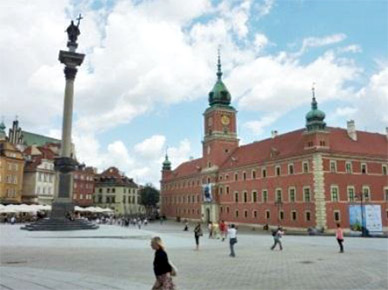 It stands on the edge of its own square, in the centre of which is a tall column topped by a statue of King Sigismund III Wasa, who moved the capital from Krakow to Warsaw. After the Uprising the Germans blew up the castle, even planting dynamite in the foundations. Reconstruction began in 1971 and was not finished until 1984. The visit is to the royal apartments and state rooms, and they have been beautifully redone. The Canaletto Room contains a marvellous set of paintings by Bernardo Bellotto, who was the nephew of the better-known painter of Venice and who also called himself Canaletto. This is a source of some confusion, probably deliberate in some cases, and heightened by the fact that the styles are very similar. The paintings of the Polish Canaletto are just as exquisitely detailed as those of his uncle, and were of great assistance when it came to rebuild the city after the war.
It stands on the edge of its own square, in the centre of which is a tall column topped by a statue of King Sigismund III Wasa, who moved the capital from Krakow to Warsaw. After the Uprising the Germans blew up the castle, even planting dynamite in the foundations. Reconstruction began in 1971 and was not finished until 1984. The visit is to the royal apartments and state rooms, and they have been beautifully redone. The Canaletto Room contains a marvellous set of paintings by Bernardo Bellotto, who was the nephew of the better-known painter of Venice and who also called himself Canaletto. This is a source of some confusion, probably deliberate in some cases, and heightened by the fact that the styles are very similar. The paintings of the Polish Canaletto are just as exquisitely detailed as those of his uncle, and were of great assistance when it came to rebuild the city after the war.
The beautiful Baltic port of Gdansk is another extraordinary example of a Polish city that was pounded flat in WW2, and now is a place of peace and beauty, exactly as it was centuries ago. Even by Polish standards, Gdansk has a complicated history. Originally a fishing village in the 9th century, it was taken over by the Teutonic Order in 1308 and their Polish occupants slaughtered. 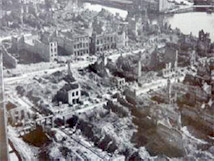 Over the next 200 years or so the Polish people recovered the city and developed the port into a fortified and highly influential member of the Hanseatic trading league. It withstood the 17th century Swedish onslaught and annexation by Prussia in the First Partition of 1772, but Prussia took over the surrounding lands and eventually the city in the Second Partition. After WW1 the Treaty of Versailles gave Poland a strip of land down the Vistula valley to Torun, the Polish Corridor, but that lasted only until Hitler’s power increased. The first shots in WW2 were fired on 1 September 1939 by a German dreadnought on the fort at Westerplatte, a peninsula at the entrance to the port. In the last year of the war the city was flattened by the attacking (“liberating”!) Russian armies. The German population fled, and were replaced by Poles from the east whose territories were lost to the Soviets.
Over the next 200 years or so the Polish people recovered the city and developed the port into a fortified and highly influential member of the Hanseatic trading league. It withstood the 17th century Swedish onslaught and annexation by Prussia in the First Partition of 1772, but Prussia took over the surrounding lands and eventually the city in the Second Partition. After WW1 the Treaty of Versailles gave Poland a strip of land down the Vistula valley to Torun, the Polish Corridor, but that lasted only until Hitler’s power increased. The first shots in WW2 were fired on 1 September 1939 by a German dreadnought on the fort at Westerplatte, a peninsula at the entrance to the port. In the last year of the war the city was flattened by the attacking (“liberating”!) Russian armies. The German population fled, and were replaced by Poles from the east whose territories were lost to the Soviets.
The rebuild of the old city since near-extinction is truly remarkable, even by the standards of Dresden and Warsaw, with meticulous reconstruction of its appearance in the 16th century. Gdansk seems to have a unique capacity for finding a place in the centre of Europe’s most turbulent history, and another example of this observation is at what was Gate 2 of the Lenin shipyard. This is where the workers first rebelled in response to Soviet oppression, and 12 of them were shot. It is the place where in the Solidarity movement evolved and continued the struggle under the leadership of the charismatic but dour Lech Walesa. The final strikes in 1989 led to the talks that led to power-sharing, democratic elections, and the final downfall of communist influence in eastern Europe.
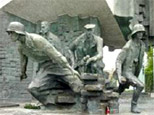 Naturally, the history of wars centred on Poland shadows the experience of travel there. Several magnificent castles and fortified mansions were destroyed by the Swedish Deluge. The heroic resistance of Jews in the Warsaw ghetto, and of the Polish people in the Warsaw uprising, are both inspiring. In WW2 The Nazis built more concentration and extermination camps in Poland than anywhere else. Visiting and wandering through the two camps in the Auschwitz-Birkenau complex, and the vast expanse of Majdanec near Lublin, is emotionally exhausting, but in our view is an experience which is a necessary step towards an understanding how and why it all happened and how it cannot be allowed to happen again. The corridors in the Auschwitz barrack blocks are lined by official photographs taken by the Nazis as part of their meticulous record-keeping. What struck us was how few were those prisoners who exhibited fear in these photos: disinterest and acceptance in many, hostility and pride in others, and outright anger in a few.
Naturally, the history of wars centred on Poland shadows the experience of travel there. Several magnificent castles and fortified mansions were destroyed by the Swedish Deluge. The heroic resistance of Jews in the Warsaw ghetto, and of the Polish people in the Warsaw uprising, are both inspiring. In WW2 The Nazis built more concentration and extermination camps in Poland than anywhere else. Visiting and wandering through the two camps in the Auschwitz-Birkenau complex, and the vast expanse of Majdanec near Lublin, is emotionally exhausting, but in our view is an experience which is a necessary step towards an understanding how and why it all happened and how it cannot be allowed to happen again. The corridors in the Auschwitz barrack blocks are lined by official photographs taken by the Nazis as part of their meticulous record-keeping. What struck us was how few were those prisoners who exhibited fear in these photos: disinterest and acceptance in many, hostility and pride in others, and outright anger in a few.
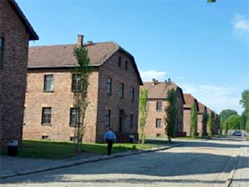
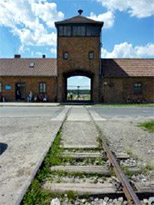 It seems to us that the Holocaust took on a life of its own, directed on ideological lines but with hands-on implementation undertaken largely by people – men and women – who could see nothing wrong in what they were doing. Their reasons appear to have ranged from indifference to outright anti-Semitism based on personal beliefs or effective Nazi propaganda. No “Hitler Directive” requiring elimination of the Jews during the war has been found, but there does appear to have been a corporate belief in Nazi circles that it was something that had to be done and that Hitler supported a “final solution” at this time. The diversion of would-be war effort to these activities was, of course, staggering, and certainly harmed Germany’s prosecution of the war. Sadly, the generally anti-Semitic attitude of the Polish people did little to counter the Nazis’ efforts to slaughter the Jews, and few now live in Poland.
It seems to us that the Holocaust took on a life of its own, directed on ideological lines but with hands-on implementation undertaken largely by people – men and women – who could see nothing wrong in what they were doing. Their reasons appear to have ranged from indifference to outright anti-Semitism based on personal beliefs or effective Nazi propaganda. No “Hitler Directive” requiring elimination of the Jews during the war has been found, but there does appear to have been a corporate belief in Nazi circles that it was something that had to be done and that Hitler supported a “final solution” at this time. The diversion of would-be war effort to these activities was, of course, staggering, and certainly harmed Germany’s prosecution of the war. Sadly, the generally anti-Semitic attitude of the Polish people did little to counter the Nazis’ efforts to slaughter the Jews, and few now live in Poland.
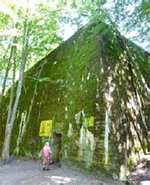
 A less emotionally demanding but very interesting visit was to the complex of bunkers built by the Germans and from where Hitler and his senior staff and generals ran their war from 1941 to 1945. It was known as the Wolfsschanze, The "Wolf's Lair". The Allies knew nothing of this complex, hidden in the forests of the north east, until after the war was over. When the Germans left in the face of the advancing Russian armies, they tried to blow the whole place up, but so massively strong was it that we could still stroll through the only partially collapsed ruins of offices and dwellings, including Hitler’s own bunker. What was completely destroyed was the unfortified conference centre where Hitler survived the attempt on his life which, if it had succeeded, would have saved the lives of thousands of people in the Armageddon of the war’s last year.
A less emotionally demanding but very interesting visit was to the complex of bunkers built by the Germans and from where Hitler and his senior staff and generals ran their war from 1941 to 1945. It was known as the Wolfsschanze, The "Wolf's Lair". The Allies knew nothing of this complex, hidden in the forests of the north east, until after the war was over. When the Germans left in the face of the advancing Russian armies, they tried to blow the whole place up, but so massively strong was it that we could still stroll through the only partially collapsed ruins of offices and dwellings, including Hitler’s own bunker. What was completely destroyed was the unfortified conference centre where Hitler survived the attempt on his life which, if it had succeeded, would have saved the lives of thousands of people in the Armageddon of the war’s last year.
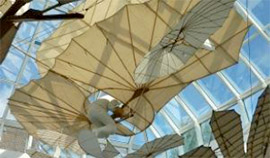 We meandered down the Baltic coast of Poland and its continuation into Germany, visiting the V1 and V2 rocket development site at Peenemunde and on to a fascinating museum describing the life and work of Otto Lilienthal. Lilienthal was one of the greatest early pioneers of manned flight, and his astonishingly detailed analysis of the physics of bird flight published in 1889 was a significant inspiration for the Wright brothers a short while later. He died when crashing one of his first powered designs – the “missionary of human flight”, as the Wrights called him.
We meandered down the Baltic coast of Poland and its continuation into Germany, visiting the V1 and V2 rocket development site at Peenemunde and on to a fascinating museum describing the life and work of Otto Lilienthal. Lilienthal was one of the greatest early pioneers of manned flight, and his astonishingly detailed analysis of the physics of bird flight published in 1889 was a significant inspiration for the Wright brothers a short while later. He died when crashing one of his first powered designs – the “missionary of human flight”, as the Wrights called him.
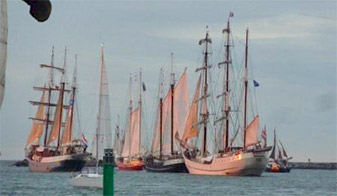 The port city of Rostock, and its gateway to the sea at Warnemunde, were just at the start of a major four-day festival of tall ships and the sea when we arrived, and a spectacular sight one evening was a parade of classic vessels glowing orange as they sailed out to sea in the light of the setting sun. The next port along was the pleasant old city of Bremen. This was once a major player in the Hanseatic League, trading in coffee and wool, and still retains its status as a town state.
The port city of Rostock, and its gateway to the sea at Warnemunde, were just at the start of a major four-day festival of tall ships and the sea when we arrived, and a spectacular sight one evening was a parade of classic vessels glowing orange as they sailed out to sea in the light of the setting sun. The next port along was the pleasant old city of Bremen. This was once a major player in the Hanseatic League, trading in coffee and wool, and still retains its status as a town state. 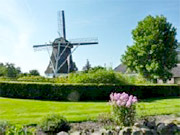 The old town is surrounded by water, the River Weser along one side and around the back a canal offshoot from the river, with zig-zagging grassy banks. Very appealing.
The old town is surrounded by water, the River Weser along one side and around the back a canal offshoot from the river, with zig-zagging grassy banks. Very appealing.
Down through the Netherlands we chose an inland route, less travelled by visitors, and to Arnhem, or more specifically Oosterbeek, where our primary target was the superb National Airborne Museum. The museum tells the story of Montgomery’s Operation Market Garden, aimed at speeding the Allied advance through Europe and cutting off the Ruhr. The essential part of this plan was the capture of important bridges over the Maas, Waal and Neder Rhine rivers, using airborne troops supported by a rapidly moving XXX Corps. But the advance was poorly planned and too slow, and the “bridge too far” was the one at Arnhem which, although captured and held by Lt Col John Frost and the paratroops who had been dropped behind enemy lines north and west of the city, finally had to be evacuated.
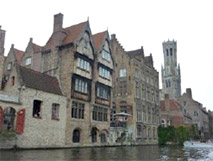 Then over the invisible European border into Belgium and to the splendid and lovely old trading city of Bruges. We enjoyed the sights of the old Flemish houses and warehouses, churches and bell towers. We even bought one of our few real souvenirs ever, a lovely Flemish tapestry. We then took a boat trip, a vastly popular 30-minute ride through some of the better-known canals that thread the city. Not far away is Ypres, another town famous for its war history. We were there primarily to visit the “In Flanders Fields” WW1 museum, sited in the old Cloth Hall.
Then over the invisible European border into Belgium and to the splendid and lovely old trading city of Bruges. We enjoyed the sights of the old Flemish houses and warehouses, churches and bell towers. We even bought one of our few real souvenirs ever, a lovely Flemish tapestry. We then took a boat trip, a vastly popular 30-minute ride through some of the better-known canals that thread the city. Not far away is Ypres, another town famous for its war history. We were there primarily to visit the “In Flanders Fields” WW1 museum, sited in the old Cloth Hall. 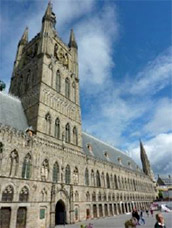 This is a magnificent building, obviously reconstructed after WW1 but still overseeing the already beautiful, large, central market square. The cathedral sits behind it. Another lovely building is the old Town Hall, with its multiple dormers. The museum is an excellent one, very impressive, balancing very well the new museum style of immersion in events, moving pictures and personal stories, with the traditional didactic style, leading the visitor through the story stage by stage. It is obviously focused on Ypres and the several battlefields around it, but also places the war in a larger context of territorial ambitions. It notes the Australian – and other Colonial, particularly Kiwi and Indian – contribution to the conflict, and describes how an Iron Cross was won by a German soldier who rescued another who was wounded: one Adolf Hitler. (If he had failed to do so, would WW2 have happened, and millions died? Of such minuscule events is history made.) On our way out of town we stopped for a quick look at the Menin Gate to the town, the site of a ferocious battle and now a huge memorial shrine inscribed by the thousands of names of some of those who died in the Ypres Salient and whose bodies were never identified.
This is a magnificent building, obviously reconstructed after WW1 but still overseeing the already beautiful, large, central market square. The cathedral sits behind it. Another lovely building is the old Town Hall, with its multiple dormers. The museum is an excellent one, very impressive, balancing very well the new museum style of immersion in events, moving pictures and personal stories, with the traditional didactic style, leading the visitor through the story stage by stage. It is obviously focused on Ypres and the several battlefields around it, but also places the war in a larger context of territorial ambitions. It notes the Australian – and other Colonial, particularly Kiwi and Indian – contribution to the conflict, and describes how an Iron Cross was won by a German soldier who rescued another who was wounded: one Adolf Hitler. (If he had failed to do so, would WW2 have happened, and millions died? Of such minuscule events is history made.) On our way out of town we stopped for a quick look at the Menin Gate to the town, the site of a ferocious battle and now a huge memorial shrine inscribed by the thousands of names of some of those who died in the Ypres Salient and whose bodies were never identified.
We crossed the Channel back to England in late August, and lovingly caught up with as many of our UK friends and relatives as we could. We thank them all for their love and hospitality.
